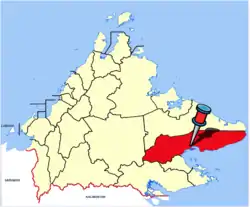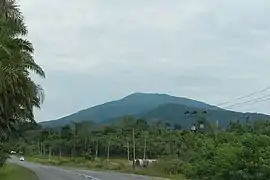Lahad Datu District
The Lahad Datu District (Malay: Daerah Lahad Datu) is an administrative district in the Malaysian state of Sabah, part of the Tawau Division which includes the districts of Kunak, Lahad Datu, Semporna and Tawau. The capital of the district is in Lahad Datu Town.
Lahad Datu District
Daerah Lahad Datu | |
|---|---|
 Seal | |
 | |
| Coordinates: 5°01′48″N 118°20′24″E | |
| Country | |
| State | |
| Division | Tawau |
| Capital | Lahad Datu |
| Government | |
| • District Officer | Zulkifli Nasir |
| Area | |
| • Total | 6,501 km2 (2,510 sq mi) |
| Population (2010) | |
| • Total | 199,830 |
| Website | ww2 ww2 |

Etymology
The word "Lahad Datu" comes from the Bajau language, "Lahad" means the place and "Datu" means the dignity of certain people during the sultanate era. The place name traced its roots from the migration of Datu-datu from the Sultanate of Sulu led by Datu Puti as a result of the handing over this area by the Sultanate of Brunei to Sulu after the Brunei Civil War.[1]
History

Following the acquisition of this area by the North Borneo Chartered Company, the Lahad Datu District was established and it subsequently became the major producer of tobacco for the company beside coconut plantation to produce copra.[2]
On 11 February 2013, several armed Filipino supporters of the Sultanate of Sulu, calling themselves the Royal Security Forces of the Sultanate of Sulu and North Borneo, arrived in Lahad Datu district and occupied the village of Tanduo. They were sent by Jamalul Kiram III, a claimant to the throne of the sultanate. His stated goal is to assert the Philippine territorial claim to eastern Sabah as part of the North Borneo dispute.[3][4][5] In response, Malaysian security forces surrounded the village. After several negotiations with the group by the Philippine and Malaysian governments to reach a peaceful solution were unsuccessful, the standoff escalated into an armed conflict which ended with 56 followers of the self-proclaimed Sultanate dead and the others captured by the Malaysian authorities.[6][7][8] The Malaysian side also suffered 10 lives lost during the conflict, along with an additional six civilians.[9][10][11]
Demographics
According to the last census in 2010, the population of Lahad Datu district is estimated to be around 199,830 inhabitants.[12] As in other districts of Sabah, there are a significant number of illegal immigrants from the nearby southern Philippines, mainly from the Sulu Archipelago and Mindanao, many of whom are not included in the population statistics. The population of the district is divided among the larger communities and the total area of the district as follows:
| Lahad Datu District | 199,830 inhabitants |
|---|---|
| Lahad Datu | 27,887 |
| Tungku | 1,085 |
| Remaining areas | 170,858 |
Tourism
The district has several tourist attractions, including Danum Valley Conservation Area, Tabin Wildlife Reserve and the Madai Cave.
Gallery
 Ar Raudah Mosque.
Ar Raudah Mosque. St. Mark Anglican Church.
St. Mark Anglican Church. Lahad Datu Basel Church.
Lahad Datu Basel Church. Che Yee Khor Moral Uplifting Society.
Che Yee Khor Moral Uplifting Society. Guan Yin Temple.
Guan Yin Temple. Gurdwara Sahib Lahad Datu.
Gurdwara Sahib Lahad Datu. Mount Silam.
Mount Silam. Tower of Heaven.
Tower of Heaven.
See also
References
- "Profil Daerah" (in Malay). Lahad Datu District Office. Archived from the original on 8 November 2017. Retrieved 8 November 2017.
- "Pengenalan Daerah Lahad Datu" (in Malay). Lahad Datu District Council. Archived from the original on 8 November 2017. Retrieved 8 November 2017.
- "Heirs of Sultan of Sulu pursue Sabah claim on their own". Philippine Daily Inquirer. 16 February 2013. Retrieved 20 February 2013.
- Michael Lim Ubac; Dona Z. Pazzibugan (3 March 2013). "No surrender, we stay". Philippine Daily Inquirer. Retrieved 3 March 2013.
- Jethro Mullen (15 February 2013). "Filipino group on Borneo claims to represent sultanate, Malaysia says". CNN. Retrieved 25 February 2013.
- M. Jegathesan (5 March 2013). "Malaysia attacks Filipinos to end Sabah siege". Philippine Daily Inquirer. Retrieved 5 March 2013.
- "Lahad Datu: Malaysian security forces in all out attack against Sulu gunmen". The Star. 5 March 2013. Archived from the original on 7 March 2013. Retrieved 5 March 2013.
- "Lahad Datu: Sabah CPO - No halt to Ops Daulat until Sulu terrorists are flushed out". The Star. 30 March 2013. Retrieved 30 June 2014.
- "Kronologi pencerobohon Lahad Datu" (in Malay). Astro Awani. 15 February 2014. Retrieved 27 February 2014.
- "Dakwaan anggota tentera terbunuh hanya taktik musuh - Panglima Tentera Darat" (in Malay). Astro Awani. 12 August 2013. Retrieved 30 June 2014.
- Najiah Najib (30 December 2013). "Lahad Datu invasion: A painful memory of 2013". Astro Awani. Retrieved 30 December 2013.
- "Population by ethnic group, Local Authority area and state, Malaysia" (PDF). Department of Statistics, Malaysia. 2010. Archived from the original (PDF) on 27 February 2012. Retrieved 5 November 2017.
Further reading
- Treacher, W. H (1891). "British Borneo: sketches of Brunai, Sarawak, Labuan, and North Borneo". University of California Libraries. Singapore, Govt. print. dept. p. 190.
- Rutter, Owen (1922). "British North Borneo - An Account of its History, Resources and Native Tribes". Cornell University Libraries. Constable & Company Ltd, London. p. 157.
- Tregonning, K. G. (1965). A History Of Modern Sabah (North Borneo 1881–1963). University of Malaya Press.
External links
![]() Media related to Lahad Datu District at Wikimedia Commons
Media related to Lahad Datu District at Wikimedia Commons
- (in Malay) Lahad Datu District Council
- (in Malay) Lahad Datu District Office